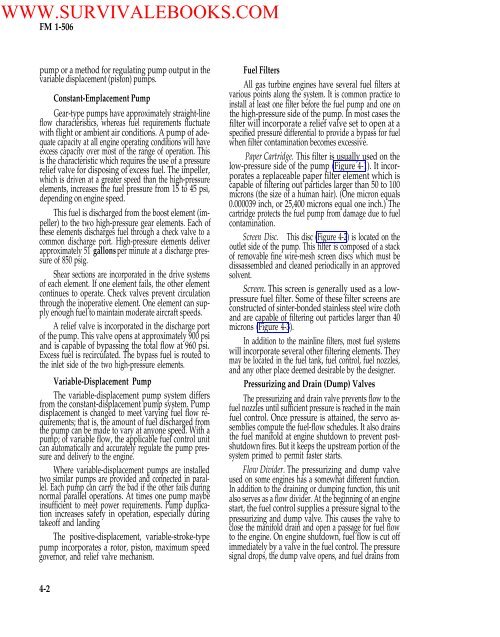FM 1-506 Fundamentals of Aircraft Power Plants ... - Survival Books
FM 1-506 Fundamentals of Aircraft Power Plants ... - Survival Books
FM 1-506 Fundamentals of Aircraft Power Plants ... - Survival Books
You also want an ePaper? Increase the reach of your titles
YUMPU automatically turns print PDFs into web optimized ePapers that Google loves.
WWW.SURVIVALEBOOKS.COM<strong>FM</strong> 1-<strong>506</strong>pump or a method for regulating pump output in thevariable displacement (piston) pumps.Constant-Emplacement PumpGear-type pumps have approximately straight-lineflow characteristics, whereas fuel requirements fluctuatewith flight or ambient air conditions. A pump <strong>of</strong> adequatecapacity at all engine operating conditions will haveexcess capacity over most <strong>of</strong> the range <strong>of</strong> operation. Thisis the characteristic which requires the use <strong>of</strong> a pressurerelief valve for disposing <strong>of</strong> excess fuel. The impeller,which is driven at a greater speed than the high-pressureelements, increases the fuel pressure from 15 to 45 psi,depending on engine speed.This fuel is discharged from the boost element (impeller)to the two high-pressure gear elements. Each <strong>of</strong>these elements discharges fuel through a check valve to acommon discharge port. High-pressure elements deliverapproximately 51 gallons per minute at a discharge pressure<strong>of</strong> 850 psig.Shear sections are incorporated in the drive systems<strong>of</strong> each element. If one element fails, the other elementcontinues to operate. Check valves prevent circulationthrough the inoperative element. One element can supplyenough fuel to maintain moderate aircraft speeds.A relief valve is incorporated in the discharge port<strong>of</strong> the pump. This valve opens at approximately 900 psiand is capable <strong>of</strong> bypassing the total flow at 960 psi.Excess fuel is recirculated. The bypass fuel is routed tothe inlet side <strong>of</strong> the two high-pressure elements.Variable-Displacement PumpThe variable-displacement pump system differsfrom the constant-displacement pump system. Pumpdisplacement is changed to meet varying fuel flow requirements;that is, the amount <strong>of</strong> fuel discharged fromthe pump can be made to vary at anyone speed. With apump; <strong>of</strong> variable flow, the applicable fuel control unitcan automatically and accurately regulate the pump pressureand delivery to the engine.Where variable-displacement pumps are installedtwo similar pumps are provided and connected in parallel.Each pump can carry the bad if the other fails duringnormal parallel operations. At times one pump maybeinsufficient to meet power requirements. Pump duplicationincreases safety in operation, especially duringtake<strong>of</strong>f and landingThe positive-displacement, variable-stroke-typepump incorporates a rotor, piston, maximum speedgovernor, and relief valve mechanism.Fuel FiltersAll gas turbine engines have several fuel filters atvarious points along the system. It is common practice toinstall at least one filter before the fuel pump and one onthe high-pressure side <strong>of</strong> the pump. In most cases thefilter will incorporate a relief valve set to open at aspecified pressure differential to provide a bypass for fuelwhen filter contamination becomes excessive.Paper Cartridge. This filter is usually used on thelow-pressure side <strong>of</strong> the pump (Figure 4-1). It incorporatesa replaceable paper filter element which iscapable <strong>of</strong> filtering out particles larger than 50 to 100microns (the size <strong>of</strong> a human hair). (One micron equals0.000039 inch, or 25,400 microns equal one inch.) Thecartridge protects the fuel pump from damage due to fuelcontamination.Screen Disc. This disc (Figure 4-2) is located on theoutlet side <strong>of</strong> the pump. This filter is composed <strong>of</strong> a stack<strong>of</strong> removable fine wire-mesh screen discs which must bedissassembled and cleaned periodically in an approvedsolvent.Screen. This screen is generally used as a lowpressurefuel filter. Some <strong>of</strong> these filter screens areconstructed <strong>of</strong> sinter-bonded stainless steel wire clothand are capable <strong>of</strong> filtering out particles larger than 40microns (Figure 4-3).In addition to the mainline filters, most fuel systemswill incorporate several other filtering elements. Theymay be located in the fuel tank, fuel control, fuel nozzles,and any other place deemed desirable by the designer.Pressurizing and Drain (Dump) ValvesThe pressurizing and drain valve prevents flow to thefuel nozzles until sufficient pressure is reached in the mainfuel control. Once pressure is attained, the servo assembliescompute the fuel-flow schedules. It also drainsthe fuel manifold at engine shutdown to prevent postshutdownfires. But it keeps the upstream portion <strong>of</strong> thesystem primed to permit faster starts.Flow Divider. The pressurizing and dump valveused on some engines has a somewhat different function.In addition to the draining or dumping function, this unitalso serves as a flow divider. At the beginning <strong>of</strong> an enginestart, the fuel control supplies a pressure signal to thepressurizing and dump valve. This causes the valve toclose the manifold drain and open a passage for fuel flowto the engine. On engine shutdown, fuel flow is cut <strong>of</strong>fimmediately by a valve in the fuel control. The pressuresignal drops, the dump valve opens, and fuel drains from4-2
















